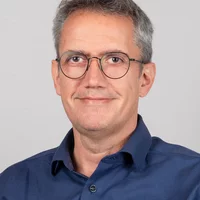Biography
Christian Appel received his undergraduate studies at the Technical University Darmstadt where he attained a B.Sc. in 2012 and M.Sc. degree in 2014 majoring in physics. In his masters, he investigated structural and rheological properties of amphiphilic core-shell macromolecules and polymers at the air-water interface using Langmuir and x-ray surface scattering experiments. Late in 2014, he continued to do his Ph.D. at TU Darmstadt in the Soft Matter physics group of Prof. Bernd Stühn. He utilised scattering techniques (x-ray reflectivity, small angle x-ray scattering and light scattering) in combination with imaging techniques (optical, atomic force and electron microscopy techniques) to structurally characterize a broad variety of systems such as amphiphilic molecules, polymers, nanoparticles and nanocomposites. Early 2019, his scientific focus shifted towards applying SAXS to characterize magnetic interactions between iron-oxide nanoparticles in ferrofluidic systems. In 2020, he started with a post-doctoral appointment within the coherent x-ray scattering (CXS) group at the Swiss Light Source (SLS) and is now a Marie Sklodowska-Curie Research Fellow under the 3i scheme at the Paul Scherrer Institut.
Institutional Responsibilities
Christian leads his own projects within the CXS group who runs the cSAXS beamline at SLS. His research constitutes the development and application of advanced x-ray imaging techniques, small-angle x-ray scattering (SAXS) imaging in 2D and 3D, but also include other imaging modalities such as ptychographic nanotomography and x-ray fluoresence. In different collaborations, he seeks to apply his fundamental understanding of scattering to investigate hierarchical structures over multiple length scales from materials of various fields, such as energy conversion, biomedical application and functional materials. These projects involve collaborations across multiple international instituts, including one with Chalmers University of Technology to transfer technical and computational knowledge on SAXS imaging to ForMAX, a beamline at MAX IV Laboratory in Sweden. Christian also fulfils an operational and user support role at the beamline and communicates his and the groups results via publication in peer-reviewed journals and conferences.
Scientific Research
The focus of Christian's research is about investigating chemical and biological processes that occur on multiple length scales. In his project, he applies SAXS imaging, x-ray fluoresence and ptychographic nanotomography to understand the hierarchical structure of a polymer electrolyte fuel cell catalyst. Another goal of the project is to explore correlative aspects between the three techniques to obtain detailed information of the hierachical catalyst structure spanning over multiple length scales (nano to millimetre) together with chemical maps of relevant elements. He is also involved in the group's developement of novel multi-modal techniques for coherent x-ray imaging as well as SAXS imaging to continously advance with new technique developments for tackling research questions from interdisciplinary fields.
Selected Publications
For a complete overview, see Google Scholar Author Page or ORCID 0000-0002-6050-3836
In situ investigation of temperature induced agglomeration in non-polar magnetic nanoparticle dispersions by small angle X-ray scattering. C Appel, B Kuttich, T Kraus, B Stühn, Nanoscale, 13, 6916, 2021. DOI: 10.1039/D0NR08434D
X-ray scattering study on the crystalline and semi-crystalline structure of water/PEG mixtures in their eutectic phase diagram. B Kuttich, A Matt, C Appel, B Stühn, Soft Matter, 16, 10260, 2020. DOI: 10.1039/D0SM01601B
Structural Properties and Magnetic Ordering in 2D Polymer Nanocomposites: Existence of Long Magnetic Dipolar Chains in Zero Field. C Appel, B Kuttich, L Stühn, RW Stark, B Stühn, Langmuir, 35, 12180, 2019. DOI: 10.1021/acs.langmuir.9b02094
Crossover from semi-dilute to densely packed thin polymer films at te air-water interface and structure formation at thin film breakup. C Appel, M Kraska, C Rüttiger, M Gallei, B Stühn, Soft Matter, 14, 4750, 2018. DOI: 10.1039/C8SM00629F


